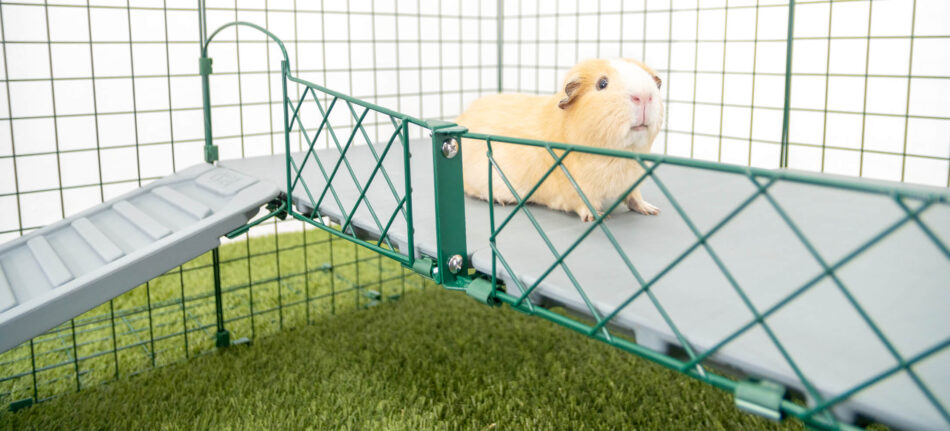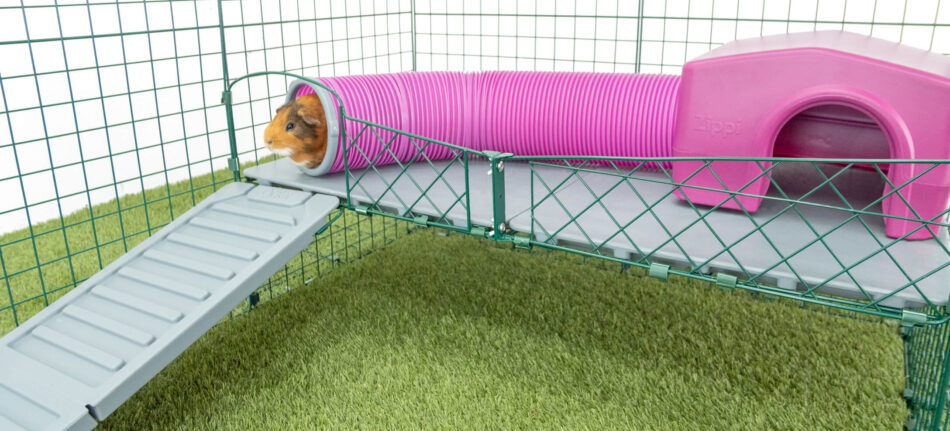How Much Exercise Do My Guinea Pigs Need?
Guinea pigs, AKA Cavia porcellus originate from the South American Andes, where they lived amongst the varying terrains of the mountains. Foraging comes naturally to this species as their ancestors spent their days exploring the rocky landscapes and grasslands to find their next source of food. And whilst these pets are not built for marathons, what they do need is a combination of hutch and run along with extra tunnels and accessories to provide them with plenty of exercise space and mental stimulation. Omlet’s guinea pig products have been expertly designed to encourage this instinct, ensuring that today’s household cavies get the exercise they need.
How do guinea pigs exercise?
Whilst small mammals of the rodent families may all look adorable, fluffy and vaguely similar, hamsters and guinea pigs do not have the same needs. Therefore, hamster-style wheels and balls are not required (and can, in fact, be very dangerous for guinea pigs). You can discover more about this topic in our What’s The Difference Between a Hamster and a Guinea Pig? blog. Instead, you should make sure that the floor area of your guinea pigs’ hutch is a minimum of 0.75 square metres for hutches containing two cavies.
The floor area is where they’ll spend much of their time, so the bigger the living quarters, the better. The indoor part of a hutch is only half the story, though, and guinea pigs need some outdoor space, too. It is recommended that they should have at least three hours each day exploring, filled with plenty of exciting exercise, where they can run, skip, and popcorn! This is easy to arrange if you combine a hutch and run, and an all-in-one living space such as The Eglu Go Hutch for Guinea Pigs is the ideal option.
Guinea pig runs can also be linked to outdoor playpens using an arrangement such as the Zippi Guinea Pig Tunnel System. Whilst guinea pigs no longer have to search amongst the terrains of the Andes for food, this kind of flexible system allows you to construct anything from a simple A to B tunnel, to a full-blown maze with a delicious vegetable hunt, allowing them to practise this behaviour. Did you know that a guinea pig’s sense of smell is actually 25x better than humans?! Therefore, a tasty vegetable hunt using your Zippi Tunnel System, Zippi Shelter, and Guinea Pig Tunnels, is the perfect setup for physically and mentally stimulating your cavies!
For a pair of Guinea pigs, a one- to two-metre-square run provides ample space. If you can to give the pets more space than this, they will only really use it fully if it has plenty of tunnels and bolt holes to head for – guinea pigs don’t like to be too far away from somewhere safe and cosy, and will not usually roam in a large garden.
How do you exercise a guinea pig? – encouraging your cavy
Guinea pigs are more inclined to run around and have fun if they have companions to play with. So, rule number one for ensuring that your pets get enough exercise is to provide them with at least one playmate. In the wild, extended family groups could be at least10, but you should always keep the numbers to a level dictated by the size of the hutch and run. You need to get the mix right, as a male and a female will inevitably mate, which has obvious consequences in terms of space and mouths to feed.
Groups of males or groups of females are the best option. A castrated male will mix very happily and placidly with females, and any small disagreement and scuffles among your guinea pigs is unlikely to result in injury and is all part of their exercise routine.
Incorporating hiding places in your run/hutch/tunnel set up is an important detail. Guinea pigs instinctively have one eye on a safe bolt-hole when they are out and about, and scurrying back to safety is probably their most strenuous form of exercise.
You can encourage your pets to scout around and stretch their legs by putting interesting objects in their run, such as a Caddi Treat Holder, wicker toys stuffed with guinea pig treats, chews, tunnels and simple hideaways in the form of terracotta caves and igloos. They will also play happily with the cardboard tubes from the inside of loo-rolls and paper towels, or a simple cardboard box, especially if these items are stuffed with hay and fresh veggie treats.
One of the things that gives guinea pigs such a unique character is their loveable combination of endless inquisitiveness and nervousness. They follow their noses, explore everything, and then dash back to safety, making those wonderful wheep wheep sounds as they do so. With this mixture of playing and bolting, their exercise needs are easily met – all you need to do is provide the hardware.
Guinea pig exercise is all about exploring and interacting. They are very sociable animals, moving around their enclosure in groups or dashing away on little adventures of their own. You can find everything you need for your fluffy friends on the Omlet Guinea Pig shop and for even more ideas on guinea pig exercise why not take a read of our Guinea Pig Activities blog?
This entry was posted in Guinea Pigs

